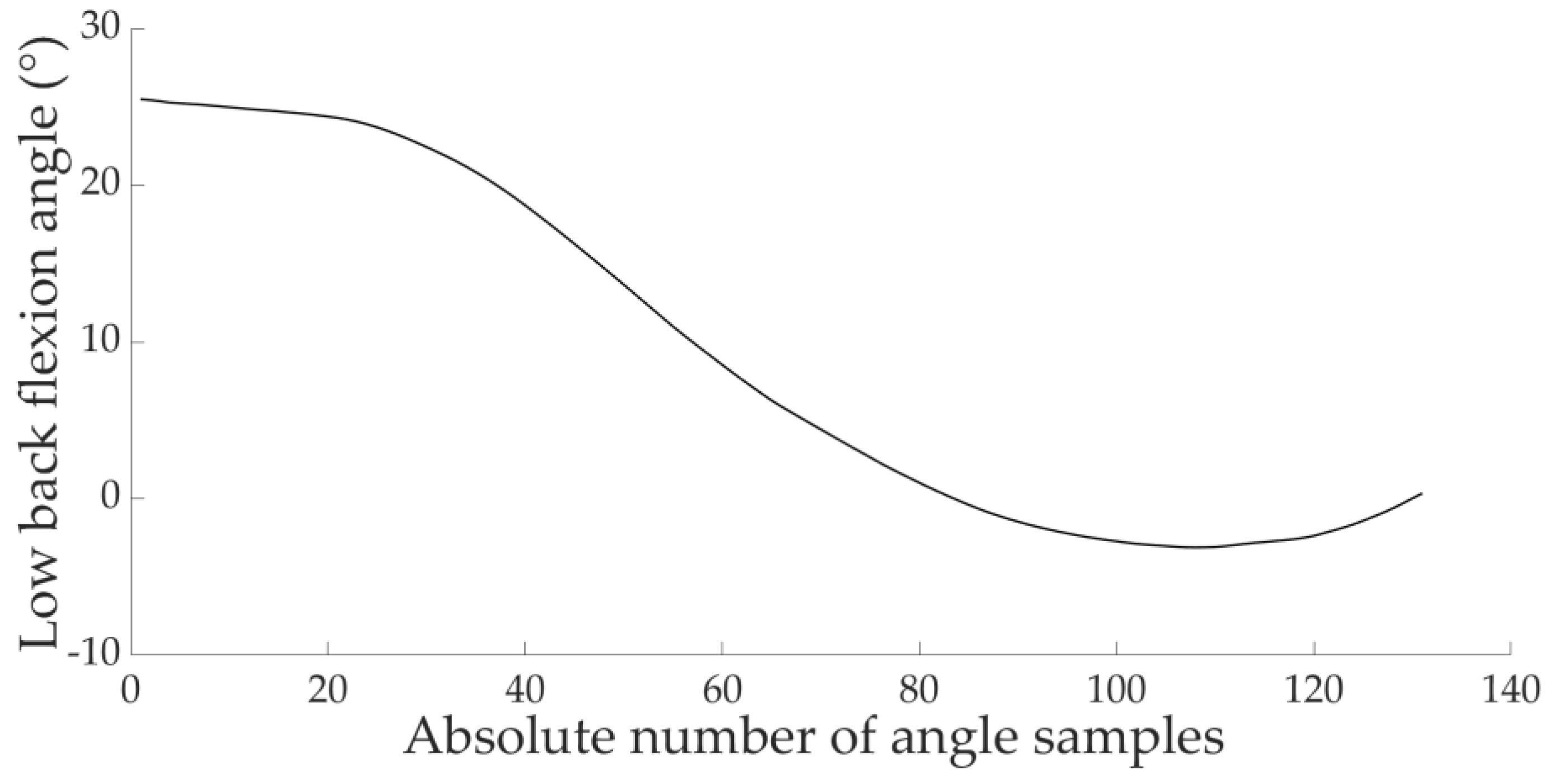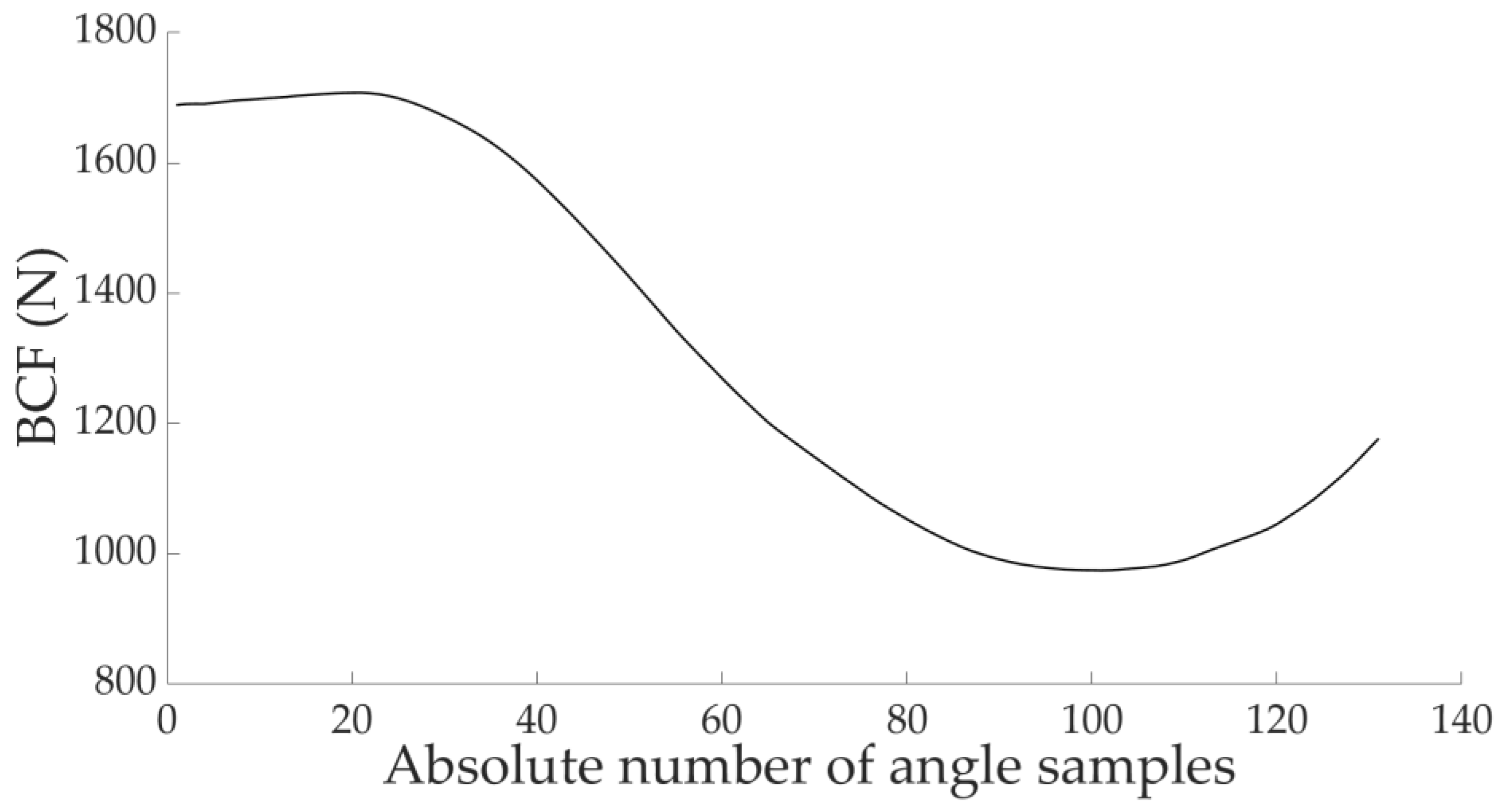Semi-Automating Low Back Compression Force Estimations with an Inertial Sensor †
Abstract
:1. Introduction
2. Materials and Methods
3. Discussion
4. Conclusions
Acknowledgments
Conflicts of Interest
References
- Hoy, D.; March, L.; Brooks, P.; Blyth, F.; Woolf, A.; Bain, C.; Williams, G.; Smith, E.; Vos, T.; Barendregt, J.; et al. The global burden of low back pain: Estimates from the Global Burden of Disease 2010 study. Ann. Rheum. Dis. 2014, 73, 968–974. [Google Scholar] [CrossRef] [PubMed]
- Australian Bureau of Statistics. Work-Related Injuries JUL 2013 to JUN 2014; Australian Bureau of Statistics: Canberra, Australia, 2015. [Google Scholar]
- Adams, M.A. Biomechanics of back pain. Acupunct. Med. 2004, 22, 178–188. [Google Scholar] [CrossRef] [PubMed]
- Hoogendoorn, W.E.; Paulien, M.B.; Henrica, C.W.; Marjolein, D.; Bart, W.K.; Mathilde, C.M.; Geertje, A.M.A.; Bouter, L.M. Flexion and rotation of the trunk and lifting at work are risk factors for low back pain: Results of a prospective cohort study. Spine 2000, 25, 3087–3092. [Google Scholar] [CrossRef] [PubMed]
- McGill, S.M. Low Back Disorders, 3rd ed.; Human Kinetics: Champaign, IL, USA, 2015. [Google Scholar]
- Luinge, H.J.; Veltink, P.H. Measuring orientation of human body segments using miniature gyroscopes and accelerometers. Med. Biol. Eng. Comput. 2005, 43, 273–282. [Google Scholar] [CrossRef] [PubMed]
- Merryweather, A.S.; Loertscher, M.C.; Bloswick, D.S. A revised back compressive force estimation model for ergonomic evaluation of lifting tasks. Work 2009, 34, 263–272. [Google Scholar] [CrossRef] [PubMed]
- El-Gohary, M.A. Joint Angle Tracking with Inertial Sensors; Portland State University: Portland, OR, USA, 2013. [Google Scholar]
- Gleadhill, S.; Lee, J.B.; James, D. The development and validation of using inertial sensors to monitor postural change in resistance exercise. J. Biomech. 2016, 49, 1259–1263. [Google Scholar] [CrossRef] [PubMed]
- Bonnechere, B.; Jansen, B.; Salvia, P.; Bouzahouene, H.; Sholukha, V.; Cornelis, J.; Rooze, M.; Van Sint Jan, S. Determination of the precision and accuracy of morphological measurements using the Kinect™ sensor: Comparison with standard stereophotogrammetry. Ergonomics 2014, 57, 622–631. [Google Scholar] [CrossRef] [PubMed]
- Spector, J.T.; Lieblich, M.; Bao, S.; McQuade, K.; Hughes, M. Automation of Workplace Lifting Hazard Assessment for Musculoskeletal Injury Prevention. Ann. Occup. Environ. Med. 2014, 26, 1–8. [Google Scholar] [CrossRef] [PubMed]
- Waters, T.R.; Putz-Anderson, V.; Garg, A. Applications Manual for the Revised NIOSH Lifting Equation; US Dept. of Health and Human Services, Public Health Service, Centers for Disease Control, National Institute for Occupational Safety and Health: Cincinnati, OH, USA, 1994. [Google Scholar]
- Leadbetter, R.; James, D. Platform technologies and Visual analytics for inertial sensors. J. Fit. Res. 2016, 5, 16–18. [Google Scholar]
- Wada, T.; Mizutani, M.; Lee, J.; Rowlands, D.; James, D. 3D Visualisation of Wearable Inertial/Magnetic Sensors. Proceedings 2018, 2, 292. [Google Scholar]
- Lai, A.; James, D.A.; Hayes, J.P.; Harvey, E.C. Semi-automatic calibration technique using six inertial frames of reference, Microelectronics: Design, Technology, and Packaging. Int. Soc. Opt. Photonics 2004, 5274, 531–543. [Google Scholar]
- Madgwick, S.O.; Harrison, A.J.; Vaidyanathan, R. Estimation of IMU and MARG orientation using a gradient descent algorithm. In Proceedings of the 2011 IEEE International Conference on Rehabilitation Robotics Proceedings, Zurich, Switzerland, 1 July 2011; pp. 1–7. [Google Scholar]
- Hopkins, W.G. Spreadsheets for Analysis of Validity and Reliability. Sportscience 2015, 21, 36–44. [Google Scholar]
- Gleadhill, S.; James, D.; Lee, J. Validating Temporal Motion Kinematics from Clothing Attached Inertial Sensors. Proceedings 2018, 2, 304. [Google Scholar]
- Hopkins, W.; Marshall, S.; Batterham, A.; Hanin, J. Progressive statistics for studies in sports medicine and exercise science. Med. Sci. Sports Exerc. 2009, 41, 3. [Google Scholar] [CrossRef] [PubMed]
- Mohsin, F.; McGarry, A.; Bowers, R.J. Factors Influencing the Reliability of the Universal Goniometer in Measurement of Lower-Limb Range of Motion: A Literature Review. J. Prosthet. Orthot. 2015, 27, 140–148. [Google Scholar] [CrossRef]
- Camomilla, V.; Bergamini, E.; Fantozzi, S.; Vannozzi, G. Trends Supporting the In-Field Use of Wearable Inertial Sensors for Sport Performance Evaluation: A Systematic Review. Sensors 2018, 18, 873. [Google Scholar] [CrossRef] [PubMed]
- Papi, E.; Koh, W.S.; McGregor, A.H. Wearable technology for spine movement assessment: A systematic review. J. Biomech. 2017, 64, 186–197. [Google Scholar] [CrossRef]



| Output | Practical | Standardised Error | Raw Error | Pearson Correlation | Mean Bias in Raw Units |
|---|---|---|---|---|---|
| Angle (°) | Inertial sensor | 0.90, large (95% CL 0.76–1.10) | 5.90° (95% CL 5.39–6.53) | r = 0.74 (95% CL 0.67–0.80) | −2.29° (95% CL −3.09–−1.48) |
| Angle (°) | Hand calculated | 2.51, extremely large (95% CL 1.82–3.92) | 8.18° (95% CL 7.46–9.04) | r = 0.37 (95% CL 0.25–0.48) | 13.38° (95% CL 11.24–15.51) |
| BCF (N) | Inertial sensor | 0.52, moderate (95% CL 0.45–0.61) | 191.61 N (95% CL 174.83–211.97) | r = 0.89 (95% CL 0.85–0.91) | −73.34 N (95% CL −100.03–−46.64) |
| BCF (N) | Hand calculated | 1.68, very large (95% CL 1.31–2.26) | 355.73 N (95% CL 324.59–393.55) | r = 0.51 (95% CL 0.40–0.61) | 399.99 N (95% CL 335.21–464.77) |
Publisher’s Note: MDPI stays neutral with regard to jurisdictional claims in published maps and institutional affiliations. |
© 2020 by the authors. Licensee MDPI, Basel, Switzerland. This article is an open access article distributed under the terms and conditions of the Creative Commons Attribution (CC BY) license (https://creativecommons.org/licenses/by/4.0/).
Share and Cite
Gleadhill, S.; James, D.; Leadbetter, R.; Wada, T.; Nagahara, R.; Lee, J. Semi-Automating Low Back Compression Force Estimations with an Inertial Sensor. Proceedings 2020, 49, 37. https://doi.org/10.3390/proceedings2020049037
Gleadhill S, James D, Leadbetter R, Wada T, Nagahara R, Lee J. Semi-Automating Low Back Compression Force Estimations with an Inertial Sensor. Proceedings. 2020; 49(1):37. https://doi.org/10.3390/proceedings2020049037
Chicago/Turabian StyleGleadhill, Sam, Daniel James, Raymond Leadbetter, Tomohito Wada, Ryu Nagahara, and James Lee. 2020. "Semi-Automating Low Back Compression Force Estimations with an Inertial Sensor" Proceedings 49, no. 1: 37. https://doi.org/10.3390/proceedings2020049037
APA StyleGleadhill, S., James, D., Leadbetter, R., Wada, T., Nagahara, R., & Lee, J. (2020). Semi-Automating Low Back Compression Force Estimations with an Inertial Sensor. Proceedings, 49(1), 37. https://doi.org/10.3390/proceedings2020049037





